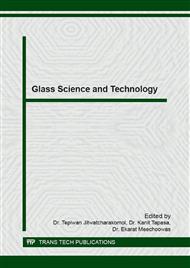p.13
p.18
p.23
p.28
p.32
p.37
p.43
p.51
p.57
Temperature Dependencies of Inter-Diffusion Coefficient and Mass-Transfer Coefficient of Chemical Strengthening
Abstract:
Chemical strengthening is a method of generating compressive stress on the glass surfaces by ion-exchange to improve their strengths since old ages. As its targets have been expanding to larger and thinner glasses recently, different strength profiles are required depending on the applications and selecting appropriate ion-exchange parameters becomes even more important. Therefore, we developed a simulation model of chemical strengthening which enables predicting the stress profiles by ion-exchange in order to help optimizing the ion-exchanging parameters. Parameter study using the simulation model with change of temperature results in precise stress prediction, the compressive stress on the surface with a margin of error of ± 3% and the depth of layer with that of ± 10%. Furthermore, the parameter study introduced following two technical findings; (1) both inter-diffusion coefficient and mass-transfer coefficient could obey the Arrhenius equation, (2) both actual temperature and fictive temperature could influence on the stress relaxation. These findings are of great importance in comprehending the phenomena associated with ion-exchange. It has possibilities for beneficial feedback to the composition development and optimum stress design in accordance with each application.
Info:
Periodical:
Pages:
32-36
Citation:
Online since:
July 2016
Authors:
Price:
Сopyright:
© 2016 Trans Tech Publications Ltd. All Rights Reserved
Share:
Citation:


